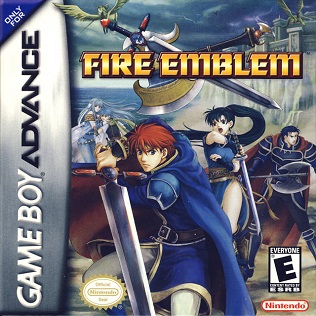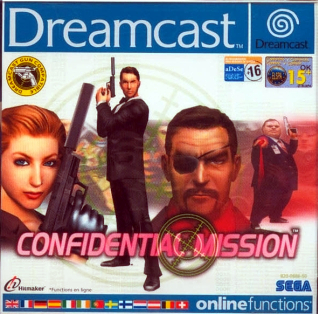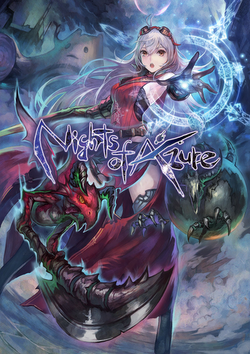
Paper Mario is a 2000 role-playing game developed by Intelligent Systems and published by Nintendo for the Nintendo 64 home video game console. Paper Mario is the first game in the Paper Mario series. First released in Japan in 2000 and then internationally in 2001, Paper Mario was later re-released for Nintendo's Wii Virtual Console in July 2007, the Wii U Virtual Console in April 2015, and the Nintendo Switch Online + Expansion Pack on December 10, 2021.

Fire Emblem: The Blazing Blade, also known simply as Fire Emblem, is a tactical role-playing game developed by Intelligent Systems and published by Nintendo for the Game Boy Advance handheld video game console. It is the seventh installment in the Fire Emblem series, the second to be released for the platform after Fire Emblem: The Binding Blade, and the first to be localized for international audiences. It was released in Japan and North America in 2003, and in Europe and Australia in 2004.

Ogre Battle: The March of the Black Queen is a 1993 real-time tactical role-playing game developed by Quest Corporation. Originally published for Super NES by Quest in Japan and by Enix America in North America. It is the first installment of the Ogre Battle series. It was directed by Yasumi Matsuno, and designed by Matsuno with Akihiko Yoshida. The story of Ogre Battle focuses on a band of rebels as they lead a revolution against a corrupt reigning Empire, ruled by an evil Empress.

Klonoa 2: Lunatea's Veil is a platform game developed and published by Namco for the PlayStation 2 in 2001. It is the direct sequel to Klonoa: Door to Phantomile (1997) for the PlayStation.

Panzer Dragoon Orta is a rail shooter game for the Xbox, developed by Smilebit and published by Sega. The fourth Panzer Dragoon game, it was released in Japan in 2002 and in North America and Europe in 2003. The story follows a girl, Orta, who is freed by a dragon and embarks on a quest to prevent the abuse of ancient technology. The gameplay features the player moving an aiming reticle and shooting enemies while the dragon flies through 3D environments on a predetermined track.

Bomberman Generation is a 2002 video game released for the GameCube. It was followed up by Bomberman Jetters.

Confidential Mission is a light gun game published by Sega, first available as an arcade game, then ported to the Dreamcast. The game is in the same style as the Virtua Cop series or The House of the Dead series, with support for one or two players. The game was developed by Sega's Hitmaker development team and first released in 2000. Its plot is of the same vein as James Bond and Mission: Impossible. Despite it also having an arcade release, it never enjoyed the popularity of the Virtua Cop nor The House of the Dead series, which were also produced by Sega.

Lost Kingdoms II, known as Rune II: Koruten no Kagi no Himitsu in Japan, is a 2003 action role-playing game developed by FromSoftware and published by Activision. The sequel to Lost Kingdoms. Lost Kingdoms II is a card-based action role-playing game where battles are fought in real-time.

Fire Emblem: Thracia 776 is a tactical role-playing game developed by Intelligent Systems and published by Nintendo for the Super Famicom; it was originally released through the Nintendo Power flash cartridge in 1999, then on a ROM cartridge the following year. It is the fifth installment in the Fire Emblem series, the third and last title to be developed for the Super Famicom, and the last home console Fire Emblem until the release of Fire Emblem: Path of Radiance in 2005.

Fire Emblem: The Binding Blade is a tactical role-playing game developed by Intelligent Systems and published by Nintendo for the Game Boy Advance (GBA) handheld video game console. It is the sixth entry in the Fire Emblem series, the first title produced for the system, and the first title to appear on a handheld console. It was released in Japan in March 2002.

Mega Man Star Force: Pegasus, Mega Man Star Force: Leo, and Mega Man Star Force: Dragon are 2006 action role-playing video games developed and published by Capcom for the Nintendo DS handheld video game console; combined, they are the first game in the Mega Man Star Force series, a sub series of the greater Mega Man franchise—and a follow-up to the Mega Man Battle Network series. It takes place in the years of 220X, in which technology has advanced to the point where the world is now connected through EM waves. The game follows Geo Stelar, a fifth-grader in Echo Ridge who merges with an FM-ian named Omega-Xis after mourning the supposed death of his father.

Deep Fear is a 1998 survival horror video game co-developed by System Sacom and Sega CS2, and published by Sega for the Sega Saturn. It was one of the last first-party titles released for Saturn, and never saw a North American release. Set on the underwater Big Table research facility, the player controls John Mayor as an unknown infection begins transforming the facility staff into hostile mutants. Gameplay has Mayor exploring the Big Table, gathering items and resources while fighting enemies.

Vampire Rain is a survival horror stealth video game developed by Artoon. It was released for the Xbox 360 in Japan on January 25, 2007, and in North America on July 3, 2007. The game was later ported to the PlayStation 3 in 2008 under the title Vampire Rain: Altered Species. It received negative reviews for its difficulty, poor artificial intelligence, and controls.

Panzer Dragoon is a series of video games developed by Sega. The first three games—Panzer Dragoon (1995), Panzer Dragoon II Zwei (1996), and Panzer Dragoon Saga (1998)—were produced by Sega's Team Andromeda for the Sega Saturn. The fourth, Panzer Dragoon Orta (2002), was developed by Sega's Smilebit team for the Xbox. Spin-offs include Panzer Dragoon Mini (1996) for the handheld Game Gear in Japan. A remake of Panzer Dragoon was released in 2020.

Valkyrie Profile: Covenant of the Plume is a tactical role-playing game developed by tri-Ace and published by Square Enix for the Nintendo DS handheld game console. Released in 2008 in Japan and 2009 worldwide, the game is the third entry in the Valkyrie Profile series, acting as a prequel to the original game.

Mega Man Star Force 3: Black Ace and Mega Man Star Force 3: Red Joker are video games developed by Capcom for the Nintendo DS handheld game console. It is the third and final game in the Mega Man Star Force series. It was released in Japan on November 13, 2008 and in United States on June 30, 2009. The game was released with two versions: Black Ace (ブラックエース) and Red Joker (レッドジョーカー). Each features a unique cover and unique character transformations, among other features. A sequel, Mega Man Star Force 4, was in development from between 2009 and 2010 when it was cancelled due to low sales of this game and Rockman EXE Operate Shooting Star.

Rune Factory 3: A Fantasy Harvest Moon is a 2009 simulation role-playing video game developed by Neverland for the Nintendo DS. It was published in Japan by Marvelous Entertainment, in North America by Natsume Inc. in 2010, and in Europe by Rising Star Games in 2011. It is the fourth game in the Rune Factory series. A remaster, Rune Factory 3 Special, was released for the Nintendo Switch in Japan in March 2023, followed by a worldwide release for both Switch and Windows in September.

Final Fantasy XVI is a 2023 action role-playing game developed and published by Square Enix. The sixteenth main installment in the Final Fantasy series, it was released for the PlayStation 5. The game features segmented open environments and an action-based combat system involving melee and magic-based attacks. There are recurring series features including Chocobos for area travel, and summoned monsters called Eikons, which are both fought as bosses and used through channelling their power in combat.

Grand Kingdom is a tactical role-playing video game developed by Monochrome Corporation for the PlayStation 4 and PlayStation Vita. It was published by Spike Chunsoft in Japan in 2015, and NIS America in the West in 2016. Following a mercenary group in the employ of different nations formed in the wake of a collapsed empire, the player engages in turn-based combat while navigating paths on maps similar to a board game. Online competitive asynchronous multiplayer where chosen teams of characters fight for a chosen nation was originally featured, but this ended as servers were shut down by 2019 in the West and 2022 in Japan.

Nights of Azure is a 2015 action role-playing video game developed by Gust and published by Koei Tecmo for the PlayStation 3, PlayStation 4, PlayStation Vita and Microsoft Windows. The PlayStation 4 version received a North American release on March 29, 2016, with a European release following on April 1, 2016, and a Microsoft Windows release on February 7, 2017.



















